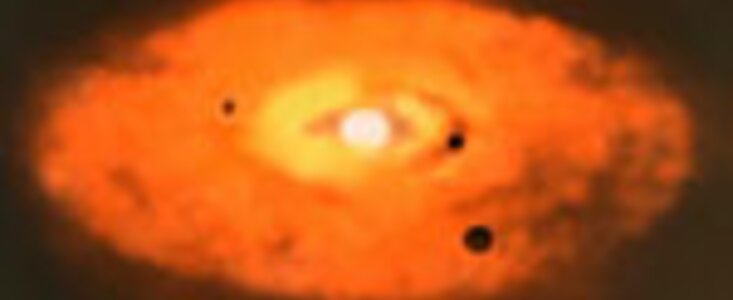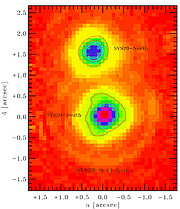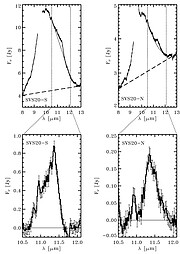Star Pair Grows Dust in Early Youth
1 Junio 2005
Dust Growth and Planet Formation
Silicates found in the general interstellar medium or molecular clouds are exclusively amorphous, non-crystalline dust grains. However, both amorphous and crystalline dust grains are observed in more evolved stellar and planetary systems including those that, while still young, are in their later stages of formation. Thus, crystalline dust is present near T Tauri and Herbig Ae/Be stars, which are only a million or so years old, debris disks such as Beta Pic, which is 15-20 million years old, and our solar system, which is billions of years old (e.g., Comet C/1996 Q1). During the early formation and evolution of the dust in these systems, crystalline silicates form by a process that is still a mystery. The earlier we can look into the process of stellar evolution the better we can understand how the dust surrounding a young star is processed.
Spectroscopy in the mid-infrared provides one of the most powerful tools available for probing the early transformation of interstellar dust clouds into the larger proto-planetary disks that will coalescence and grow into primordial planetesimals. Our understanding of proto-planetary disk evolution is accelerating due to our improved ability to explore the disks and surroundings of very young stellar systems using extremely sensitive mid-infrared instrumentation. These observations, (from both ground and space), have begun to unravel the complexities involved in the growth of planetesimals and their early evolution by collisions into protoplanetary disks. At the same time, adaptive optics systems on large ground-based telescopes have allowed us to directly image a few young massive planets.
Using the mid-infrared imager/spectrograph T-ReCS on Gemini South, David Ciardi (Michelson Science Center, Caltech) and his collaborators have found that processing of dust grains around the proto-binary star Serpens SVS20 began at a surprisingly early point in the system’s evolution.
The observations used both imaging and spectroscopic data to probe the young binary system located about 250 parsecs (815 light years) away. The system is located in the core region of the Serpens Cloud in a young protostellar cluster with an estimated age of about 100,000 years. The team’s conclusions were based on the observation of crystalline silicates associated with both stars in this young binary pair (geminiann05007b).
The young age of SVS20 (the same as its host cluster, about 100,000 years old) has allowed a detailed exploration of a critical early phase in the planetary formation process. The Ciardi et al. observations suggest that we are beginning to explore the earliest phases of planet formation, when primordial interstellar dust is being transformed into the larger and more complex particles that are the seeds of protoplanets. This analysis also indicates that the process of planetary formation, including that of our own solar system, is likely initiated during the earliest stages of stellar formation while the protostar is still accreting the majority of its mass.
The fact that the dust emission is not resolved spatially at the limit of the imaging data (FWHM 0.4 arcsecond) constrains the size of the circumstellar dust disk to within 100 astronomical units of the stars (about the size of our solar system out to the Kuiper Belt).
Although both components of the system (SVS20-North and SVS20-South) have similar broad-band energy distributions in the infrared, the temperatures and luminosities of the stars are very different. The brighter star (SVS20-South) has an effective temperature Teff ~ 7000 – 10000 K and luminosity of L ~ 20 –80 Lsun, whereas the smaller companion SVS20-N has Teff ~ 3000 K and L ~ 0.9 Lsun. The observed spectrum of SVS20-S is dominated by a strong emission feature at 11.3 microns, while that of SVS20-N is dominated by shallow absorption created by amorphous silicates. In addition to the amorphous silicates, both proto-stars show emission of crystalline silicates in the form of the minerals forsterite (Mg2SiO4) and enstatite (Mg2Si2O6) (geminiann05007c).
For more details, see the article “Crystalline Silicate Emission in the Protostellar Binary Serpens-SVS20”, by D. Ciardi, C. M. Telesco, C. Packham, C. Gomez Martin, J. T. Radomski, J. M. de Buizer, C. J. Phillips and D. Harker, The Astrophysical Journal (in press)



